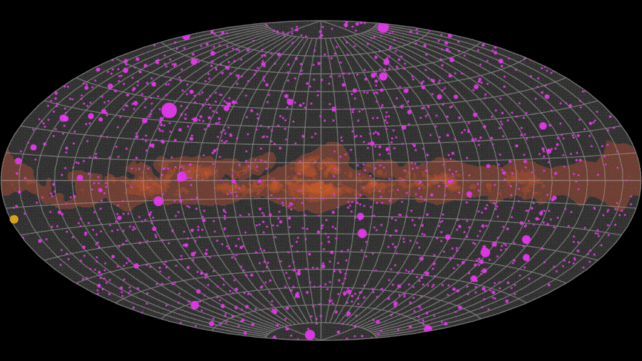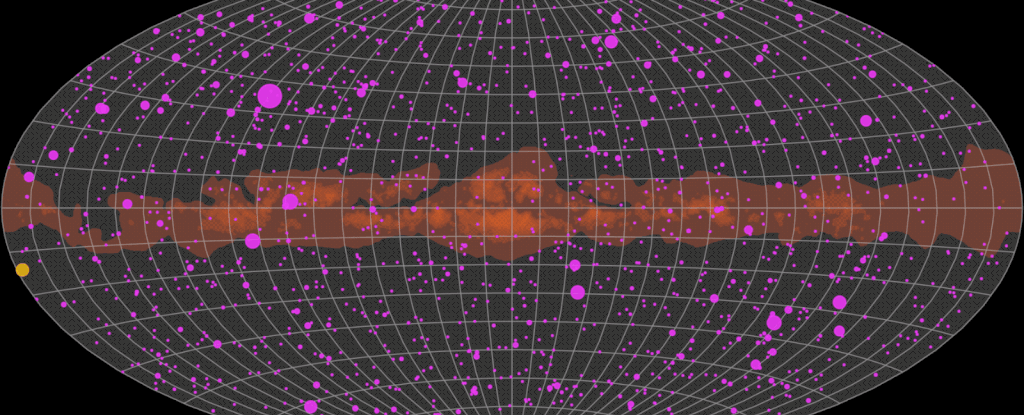Most of the light streaming through the Universe is invisible to human eyes. Beyond the mid-range wavelengths we can see, there's a whole cosmos shining in high- and low-energy radiation.
But we humans are clever little animals and have managed to build instruments that can see the light we cannot. One of these is NASA's Fermi Gamma-ray Space Telescope, an observatory hanging out in low-Earth orbit, monitoring the sky for gamma rays, the highest-energy light in the Universe.
Fermi constantly surveils the entire sky, observing gamma-ray sources and how they change over time, providing astronomers with a map of the various producers of gamma radiation that we can detect. This data is compiled into a catalog that scientists can use to probe the production of gamma radiation.
The animation represents a year of fluctuating gamma radiation from 1,525 sources, represented by pulsing purple circles, collected between February 2022 and February 2023, with each frame representing three days' worth of observations. The larger the circle, the brighter the gamma radiation.
The yellow circle, meanwhile, represents the apparent path of the Sun across the sky for that time period.
"We were inspired to put this database together by astronomers who study galaxies and wanted to compare visible and gamma-ray light curves over long time scales," says astrophysicist Daniel Kocevski of NASA's Marshall Space Flight Center in Huntsville.
"We were getting requests to process one object at a time. Now the scientific community has access to all the analyzed data for the whole catalog."

Most of the flashing lights you see come from a type of galaxy known as blazars. These are a subset of quasar galaxies. A quasar is a galaxy with an extremely active nucleus, meaning the supermassive black hole is guzzling down material at a tremendous rate. This material is heated up by the extreme activity around the black hole so that it blares across space. Quasars emit the brightest light in the Universe.
Some of these quasars have jets of plasma launched from the galactic nucleus. As the black hole feeds, some of the material swirling around it is diverted and accelerated along the magnetic field lines outside the event horizon. When it reaches the poles, this material is launched into space at high speeds, often approaching the speed of light in a vacuum.
A blazar is a quasar whose jet is pointed at, or nearly at, Earth. Because of this orientation, the light appears even brighter across the entire spectrum. Blazars are known sources of gamma radiation, but their light fluctuates on pretty short timescales; their fluctuations can help astronomers study how these giants feed.
Combined with other data, they can also help answer questions about the Universe. For instance, only recently have detections of neutrinos made by observatories such as IceCube in Antarctica been traced back to blazar galaxies.
Blazars represent over 90 percent of the gamma-ray sources in the new addition to the Fermi gamma-ray catalog. The other objects emitting gamma radiation include a type of neutron star called pulsars, the tattered remnants of material leftover by supernova explosions, and binary systems such as binary neutron stars.
And there's the gamma-ray glow of the plane of the Milky Way galaxy, represented in the animation by a blobby orange band stretching across the center of the image. There, brighter color represents a more radiant glow.
The long-period observations will hopefully provide deeper insight into some of the phenomena associated with gamma-ray sources. For instance, tracing a neutrino to a brighter period of a blazar's activity could help narrow down the processes that produce these mysterious particles.
"Having the historical light curve database," says astrophysicist Michela Negro of the University of Maryland, Baltimore County, and NASA's Goddard Space Flight Center, "could lead to new multimessenger insights into past events."
And we get a hint of how we might see the Universe if we had alien eyes.
The newly updated catalog is freely available from The Astrophysical Journal Supplement Series.
